FORD MUSTANG 2022 Warranty Guide
Manufacturer: FORD, Model Year: 2022, Model line: MUSTANG, Model: FORD MUSTANG 2022Pages: 81, PDF Size: 1.96 MB
Page 41 of 81
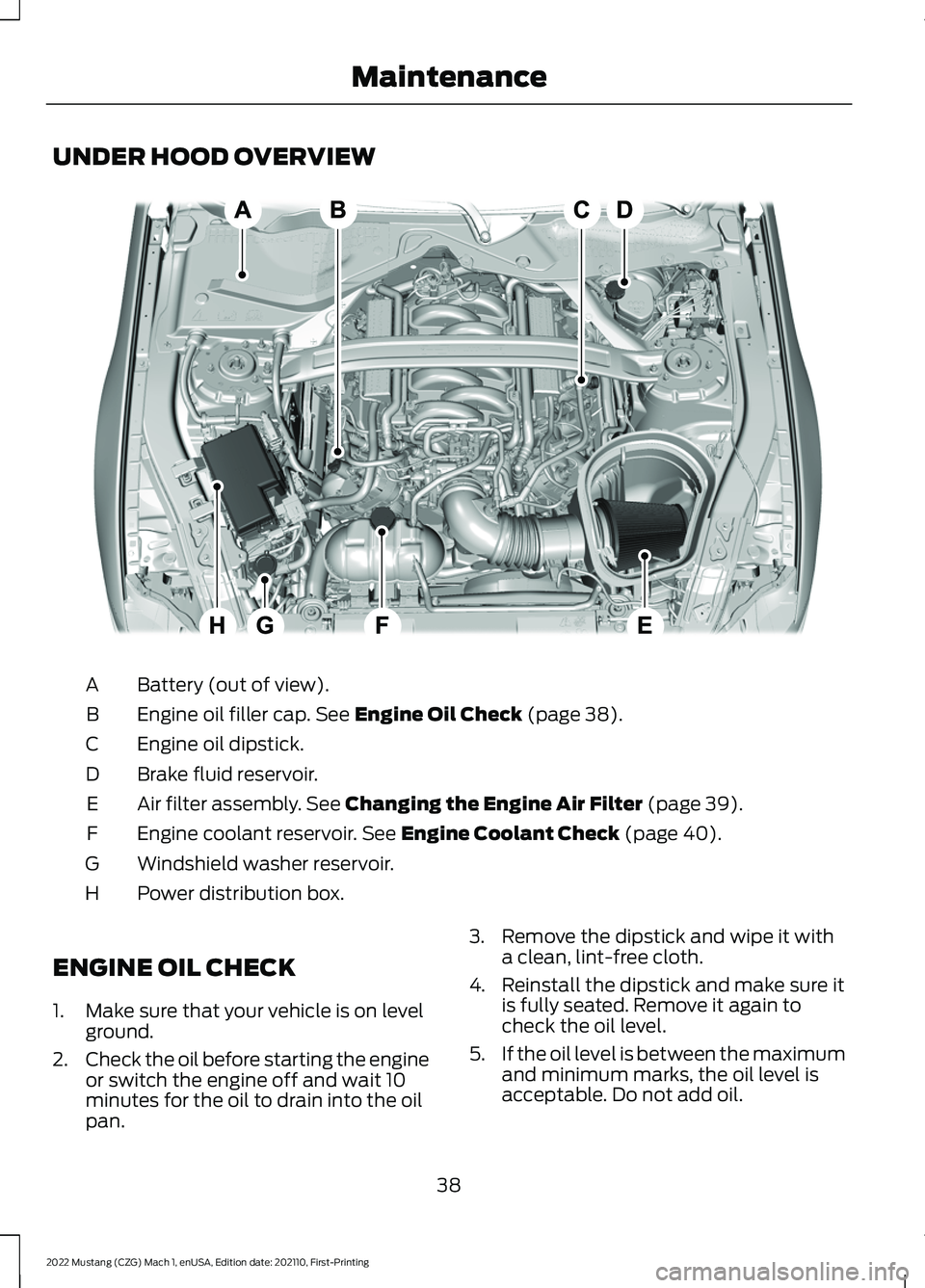
UNDER HOOD OVERVIEW
Battery (out of view).
A
Engine oil filler cap. See Engine Oil Check (page 38).
B
Engine oil dipstick.
C
Brake fluid reservoir.
D
Air filter assembly.
See Changing the Engine Air Filter (page 39).
E
Engine coolant reservoir.
See Engine Coolant Check (page 40).
F
Windshield washer reservoir.
G
Power distribution box.
H
ENGINE OIL CHECK
1. Make sure that your vehicle is on level ground.
2. Check the oil before starting the engine
or switch the engine off and wait 10
minutes for the oil to drain into the oil
pan. 3. Remove the dipstick and wipe it with
a clean, lint-free cloth.
4. Reinstall the dipstick and make sure it is fully seated. Remove it again to
check the oil level.
5. If the oil level is between the maximum
and minimum marks, the oil level is
acceptable. Do not add oil.
38
2022 Mustang (CZG) Mach 1, enUSA, Edition date: 202110, First-Printing MaintenanceE296063
Page 42 of 81
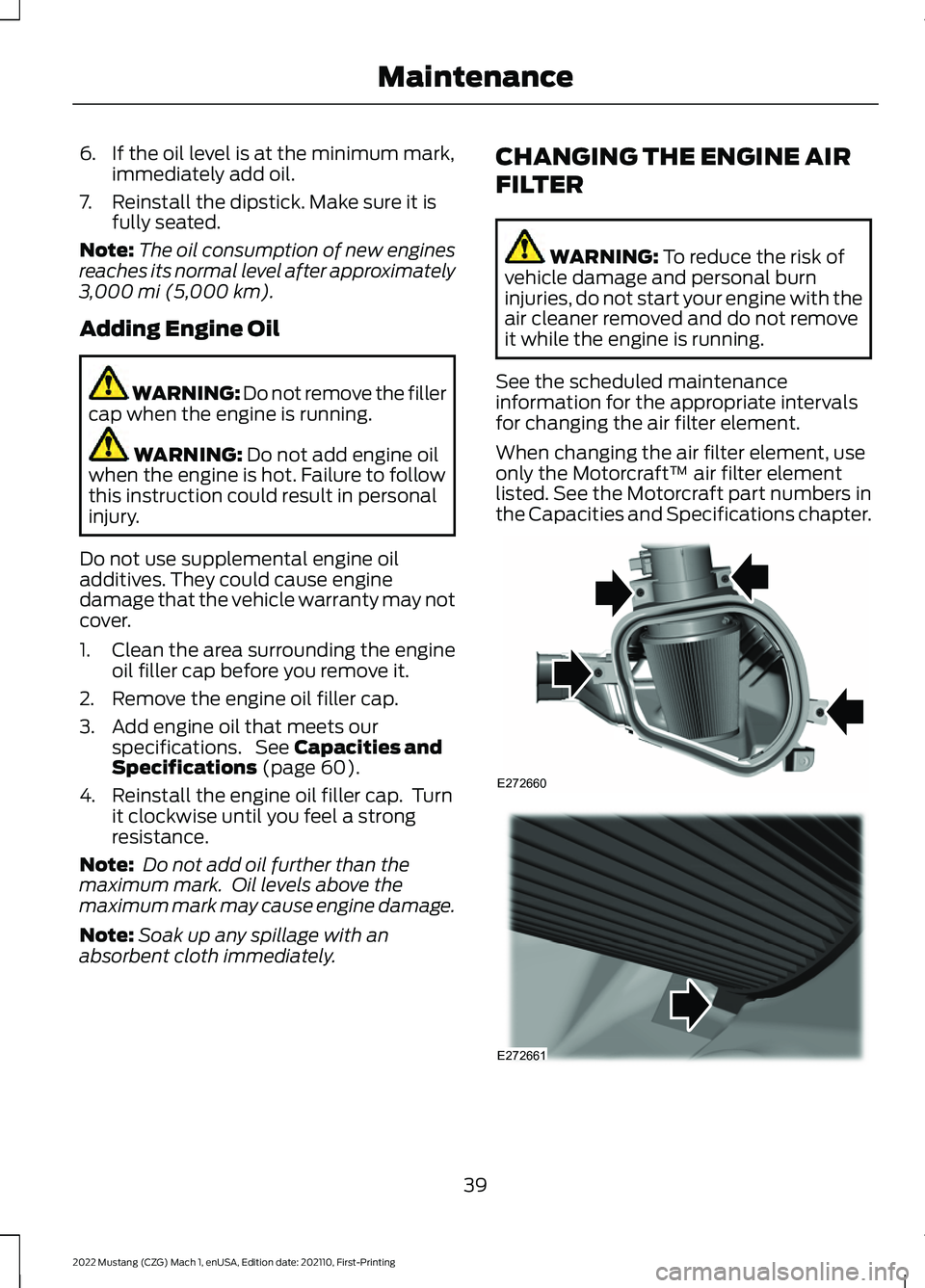
6. If the oil level is at the minimum mark,
immediately add oil.
7. Reinstall the dipstick. Make sure it is fully seated.
Note: The oil consumption of new engines
reaches its normal level after approximately
3,000 mi (5,000 km).
Adding Engine Oil WARNING: Do not remove the filler
cap when the engine is running. WARNING:
Do not add engine oil
when the engine is hot. Failure to follow
this instruction could result in personal
injury.
Do not use supplemental engine oil
additives. They could cause engine
damage that the vehicle warranty may not
cover.
1. Clean the area surrounding the engine oil filler cap before you remove it.
2. Remove the engine oil filler cap.
3. Add engine oil that meets our specifications. See
Capacities and
Specifications (page 60).
4. Reinstall the engine oil filler cap. Turn it clockwise until you feel a strong
resistance.
Note: Do not add oil further than the
maximum mark. Oil levels above the
maximum mark may cause engine damage.
Note: Soak up any spillage with an
absorbent cloth immediately. CHANGING THE ENGINE AIR
FILTER WARNING:
To reduce the risk of
vehicle damage and personal burn
injuries, do not start your engine with the
air cleaner removed and do not remove
it while the engine is running.
See the scheduled maintenance
information for the appropriate intervals
for changing the air filter element.
When changing the air filter element, use
only the Motorcraft™ air filter element
listed. See the Motorcraft part numbers in
the Capacities and Specifications chapter. 39
2022 Mustang (CZG) Mach 1, enUSA, Edition date: 202110, First-Printing MaintenanceE272660 E272661
Page 43 of 81
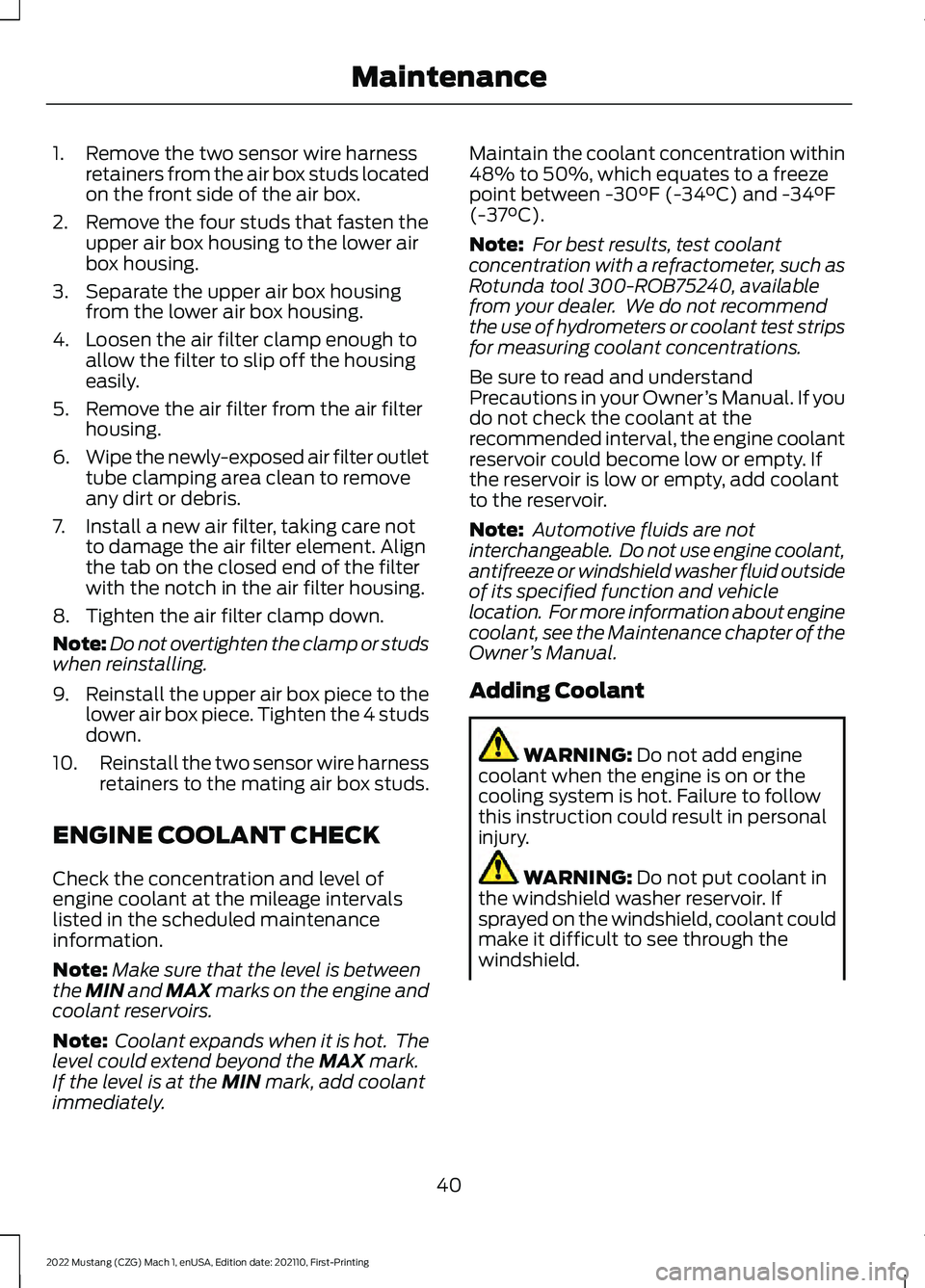
1. Remove the two sensor wire harness
retainers from the air box studs located
on the front side of the air box.
2. Remove the four studs that fasten the upper air box housing to the lower air
box housing.
3. Separate the upper air box housing from the lower air box housing.
4. Loosen the air filter clamp enough to allow the filter to slip off the housing
easily.
5. Remove the air filter from the air filter housing.
6. Wipe the newly-exposed air filter outlet
tube clamping area clean to remove
any dirt or debris.
7. Install a new air filter, taking care not to damage the air filter element. Align
the tab on the closed end of the filter
with the notch in the air filter housing.
8. Tighten the air filter clamp down.
Note: Do not overtighten the clamp or studs
when reinstalling.
9. Reinstall the upper air box piece to the
lower air box piece. Tighten the 4 studs
down.
10. Reinstall the two sensor wire harness
retainers to the mating air box studs.
ENGINE COOLANT CHECK
Check the concentration and level of
engine coolant at the mileage intervals
listed in the scheduled maintenance
information.
Note: Make sure that the level is between
the MIN and MAX marks on the engine and
coolant reservoirs.
Note: Coolant expands when it is hot. The
level could extend beyond the
MAX mark.
If the level is at the MIN mark, add coolant
immediately. Maintain the coolant concentration within
48% to 50%, which equates to a freeze
point between -30°F (-34°C) and -34°F
(-37°C).
Note:
For best results, test coolant
concentration with a refractometer, such as
Rotunda tool 300-ROB75240, available
from your dealer. We do not recommend
the use of hydrometers or coolant test strips
for measuring coolant concentrations.
Be sure to read and understand
Precautions in your Owner ’s Manual. If you
do not check the coolant at the
recommended interval, the engine coolant
reservoir could become low or empty. If
the reservoir is low or empty, add coolant
to the reservoir.
Note: Automotive fluids are not
interchangeable. Do not use engine coolant,
antifreeze or windshield washer fluid outside
of its specified function and vehicle
location. For more information about engine
coolant, see the Maintenance chapter of the
Owner ’s Manual.
Adding Coolant WARNING:
Do not add engine
coolant when the engine is on or the
cooling system is hot. Failure to follow
this instruction could result in personal
injury. WARNING:
Do not put coolant in
the windshield washer reservoir. If
sprayed on the windshield, coolant could
make it difficult to see through the
windshield.
40
2022 Mustang (CZG) Mach 1, enUSA, Edition date: 202110, First-Printing Maintenance
Page 44 of 81
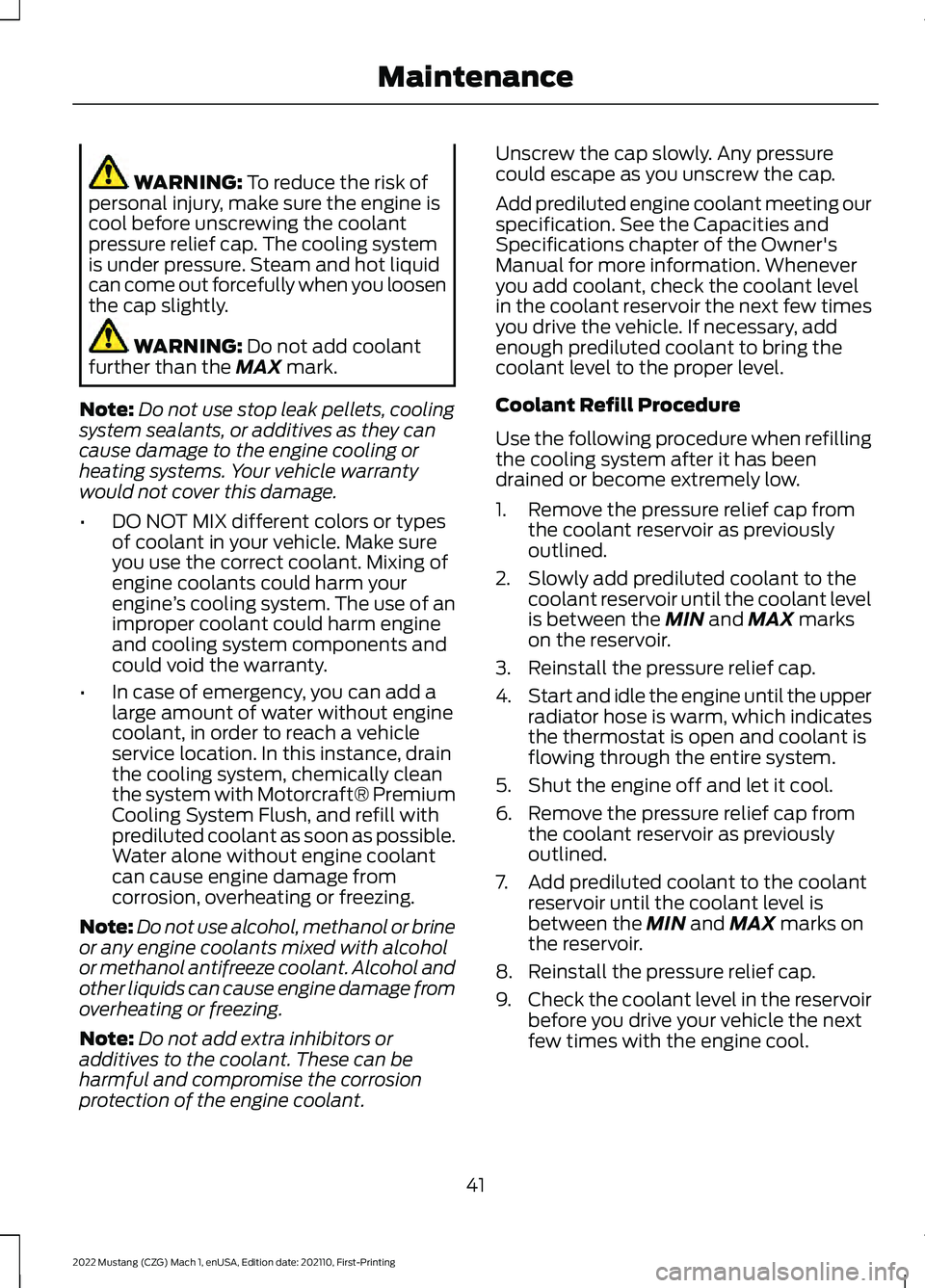
WARNING: To reduce the risk of
personal injury, make sure the engine is
cool before unscrewing the coolant
pressure relief cap. The cooling system
is under pressure. Steam and hot liquid
can come out forcefully when you loosen
the cap slightly. WARNING:
Do not add coolant
further than the MAX mark.
Note: Do not use stop leak pellets, cooling
system sealants, or additives as they can
cause damage to the engine cooling or
heating systems. Your vehicle warranty
would not cover this damage.
• DO NOT MIX different colors or types
of coolant in your vehicle. Make sure
you use the correct coolant. Mixing of
engine coolants could harm your
engine ’s cooling system. The use of an
improper coolant could harm engine
and cooling system components and
could void the warranty.
• In case of emergency, you can add a
large amount of water without engine
coolant, in order to reach a vehicle
service location. In this instance, drain
the cooling system, chemically clean
the system with Motorcraft® Premium
Cooling System Flush, and refill with
prediluted coolant as soon as possible.
Water alone without engine coolant
can cause engine damage from
corrosion, overheating or freezing.
Note: Do not use alcohol, methanol or brine
or any engine coolants mixed with alcohol
or methanol antifreeze coolant. Alcohol and
other liquids can cause engine damage from
overheating or freezing.
Note: Do not add extra inhibitors or
additives to the coolant. These can be
harmful and compromise the corrosion
protection of the engine coolant. Unscrew the cap slowly. Any pressure
could escape as you unscrew the cap.
Add prediluted engine coolant meeting our
specification. See the Capacities and
Specifications chapter of the Owner's
Manual for more information. Whenever
you add coolant, check the coolant level
in the coolant reservoir the next few times
you drive the vehicle. If necessary, add
enough prediluted coolant to bring the
coolant level to the proper level.
Coolant Refill Procedure
Use the following procedure when refilling
the cooling system after it has been
drained or become extremely low.
1. Remove the pressure relief cap from
the coolant reservoir as previously
outlined.
2. Slowly add prediluted coolant to the coolant reservoir until the coolant level
is between the
MIN and MAX marks
on the reservoir.
3. Reinstall the pressure relief cap.
4. Start and idle the engine until the upper
radiator hose is warm, which indicates
the thermostat is open and coolant is
flowing through the entire system.
5. Shut the engine off and let it cool.
6. Remove the pressure relief cap from the coolant reservoir as previously
outlined.
7. Add prediluted coolant to the coolant reservoir until the coolant level is
between the
MIN and MAX marks on
the reservoir.
8. Reinstall the pressure relief cap.
9. Check the coolant level in the reservoir
before you drive your vehicle the next
few times with the engine cool.
41
2022 Mustang (CZG) Mach 1, enUSA, Edition date: 202110, First-Printing Maintenance
Page 45 of 81
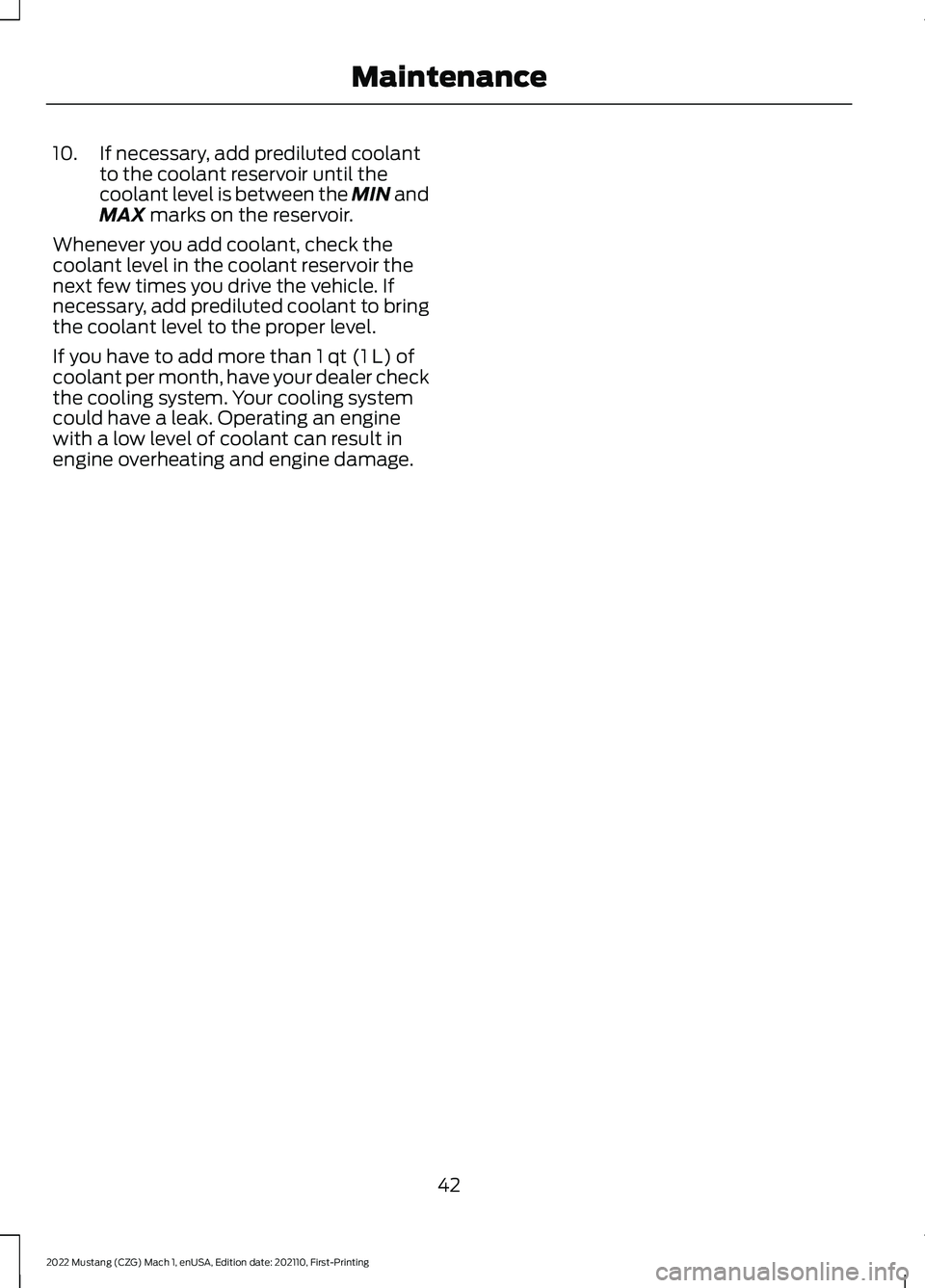
10. If necessary, add prediluted coolant
to the coolant reservoir until the
coolant level is between the MIN and
MAX marks on the reservoir.
Whenever you add coolant, check the
coolant level in the coolant reservoir the
next few times you drive the vehicle. If
necessary, add prediluted coolant to bring
the coolant level to the proper level.
If you have to add more than
1 qt (1 L) of
coolant per month, have your dealer check
the cooling system. Your cooling system
could have a leak. Operating an engine
with a low level of coolant can result in
engine overheating and engine damage.
42
2022 Mustang (CZG) Mach 1, enUSA, Edition date: 202110, First-Printing Maintenance
Page 46 of 81
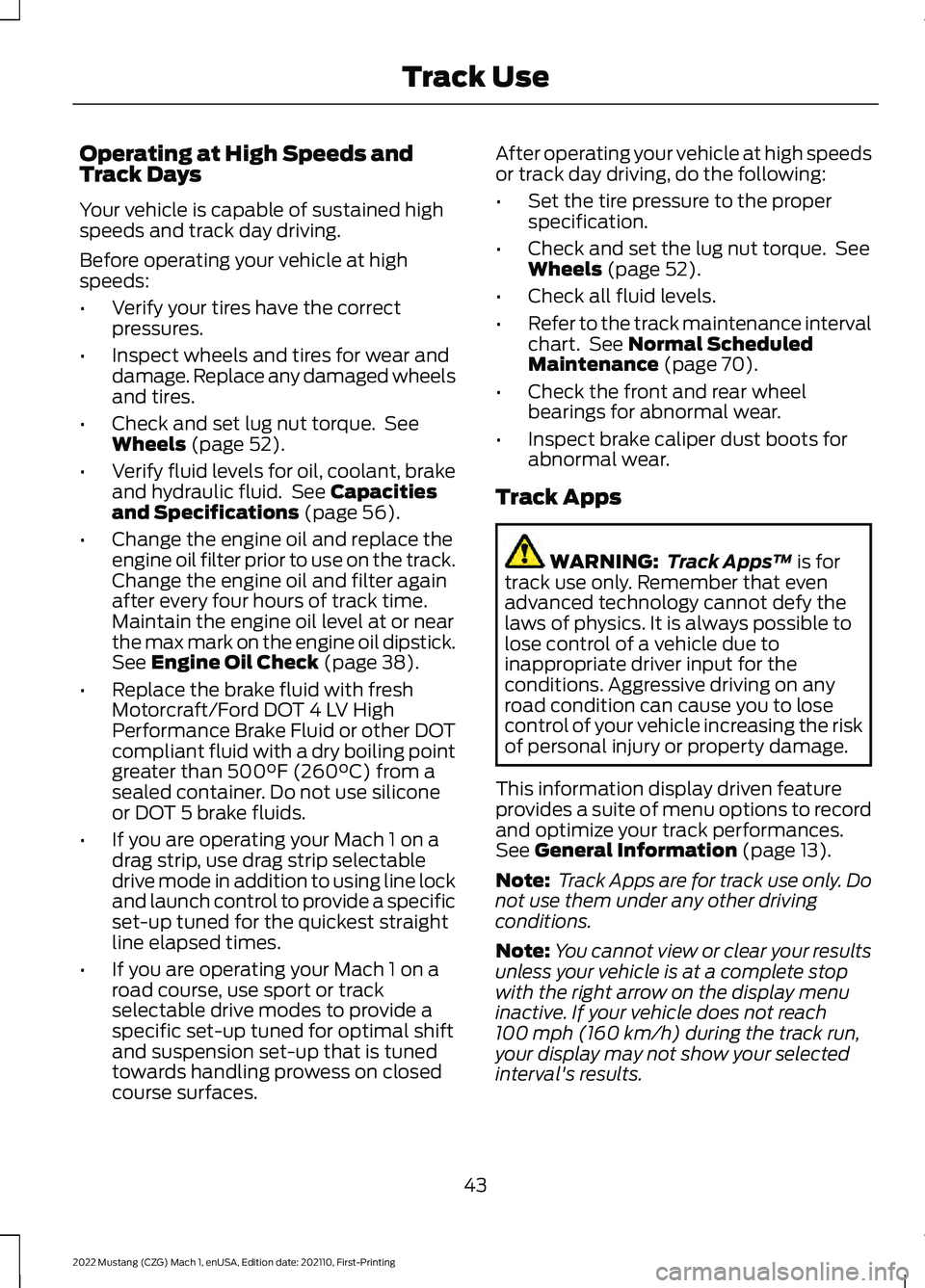
Operating at High Speeds and
Track Days
Your vehicle is capable of sustained high
speeds and track day driving.
Before operating your vehicle at high
speeds:
•
Verify your tires have the correct
pressures.
• Inspect wheels and tires for wear and
damage. Replace any damaged wheels
and tires.
• Check and set lug nut torque. See
Wheels (page 52).
• Verify fluid levels for oil, coolant, brake
and hydraulic fluid. See
Capacities
and Specifications (page 56).
• Change the engine oil and replace the
engine oil filter prior to use on the track.
Change the engine oil and filter again
after every four hours of track time.
Maintain the engine oil level at or near
the max mark on the engine oil dipstick.
See
Engine Oil Check (page 38).
• Replace the brake fluid with fresh
Motorcraft/Ford DOT 4 LV High
Performance Brake Fluid or other DOT
compliant fluid with a dry boiling point
greater than
500°F (260°C) from a
sealed container. Do not use silicone
or DOT 5 brake fluids.
• If you are operating your Mach 1 on a
drag strip, use drag strip selectable
drive mode in addition to using line lock
and launch control to provide a specific
set-up tuned for the quickest straight
line elapsed times.
• If you are operating your Mach 1 on a
road course, use sport or track
selectable drive modes to provide a
specific set-up tuned for optimal shift
and suspension set-up that is tuned
towards handling prowess on closed
course surfaces. After operating your vehicle at high speeds
or track day driving, do the following:
•
Set the tire pressure to the proper
specification.
• Check and set the lug nut torque. See
Wheels
(page 52).
• Check all fluid levels.
• Refer to the track maintenance interval
chart. See
Normal Scheduled
Maintenance (page 70).
• Check the front and rear wheel
bearings for abnormal wear.
• Inspect brake caliper dust boots for
abnormal wear.
Track Apps WARNING:
Track Apps™
is for
track use only. Remember that even
advanced technology cannot defy the
laws of physics. It is always possible to
lose control of a vehicle due to
inappropriate driver input for the
conditions. Aggressive driving on any
road condition can cause you to lose
control of your vehicle increasing the risk
of personal injury or property damage.
This information display driven feature
provides a suite of menu options to record
and optimize your track performances.
See
General Information (page 13).
Note: Track Apps are for track use only. Do
not use them under any other driving
conditions.
Note: You cannot view or clear your results
unless your vehicle is at a complete stop
with the right arrow on the display menu
inactive. If your vehicle does not reach
100 mph (160 km/h)
during the track run,
your display may not show your selected
interval's results.
43
2022 Mustang (CZG) Mach 1, enUSA, Edition date: 202110, First-Printing Track Use
Page 47 of 81
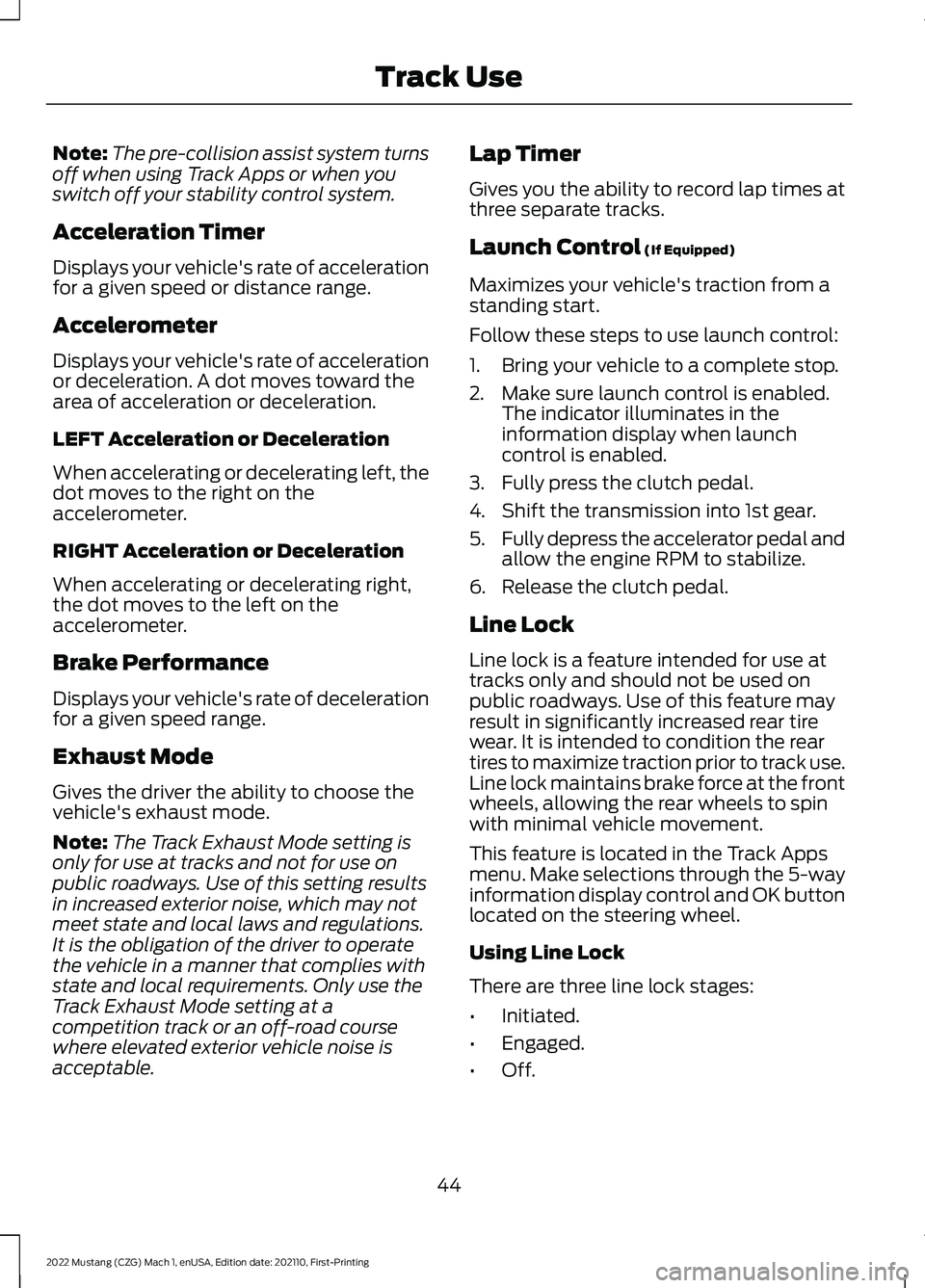
Note:
The pre-collision assist system turns
off when using Track Apps or when you
switch off your stability control system.
Acceleration Timer
Displays your vehicle's rate of acceleration
for a given speed or distance range.
Accelerometer
Displays your vehicle's rate of acceleration
or deceleration. A dot moves toward the
area of acceleration or deceleration.
LEFT Acceleration or Deceleration
When accelerating or decelerating left, the
dot moves to the right on the
accelerometer.
RIGHT Acceleration or Deceleration
When accelerating or decelerating right,
the dot moves to the left on the
accelerometer.
Brake Performance
Displays your vehicle's rate of deceleration
for a given speed range.
Exhaust Mode
Gives the driver the ability to choose the
vehicle's exhaust mode.
Note: The Track Exhaust Mode setting is
only for use at tracks and not for use on
public roadways. Use of this setting results
in increased exterior noise, which may not
meet state and local laws and regulations.
It is the obligation of the driver to operate
the vehicle in a manner that complies with
state and local requirements. Only use the
Track Exhaust Mode setting at a
competition track or an off-road course
where elevated exterior vehicle noise is
acceptable. Lap Timer
Gives you the ability to record lap times at
three separate tracks.
Launch Control (If Equipped)
Maximizes your vehicle's traction from a
standing start.
Follow these steps to use launch control:
1. Bring your vehicle to a complete stop.
2. Make sure launch control is enabled. The indicator illuminates in the
information display when launch
control is enabled.
3. Fully press the clutch pedal.
4. Shift the transmission into 1st gear.
5. Fully depress the accelerator pedal and
allow the engine RPM to stabilize.
6. Release the clutch pedal.
Line Lock
Line lock is a feature intended for use at
tracks only and should not be used on
public roadways. Use of this feature may
result in significantly increased rear tire
wear. It is intended to condition the rear
tires to maximize traction prior to track use.
Line lock maintains brake force at the front
wheels, allowing the rear wheels to spin
with minimal vehicle movement.
This feature is located in the Track Apps
menu. Make selections through the 5-way
information display control and OK button
located on the steering wheel.
Using Line Lock
There are three line lock stages:
• Initiated.
• Engaged.
• Off.
44
2022 Mustang (CZG) Mach 1, enUSA, Edition date: 202110, First-Printing Track Use
Page 48 of 81
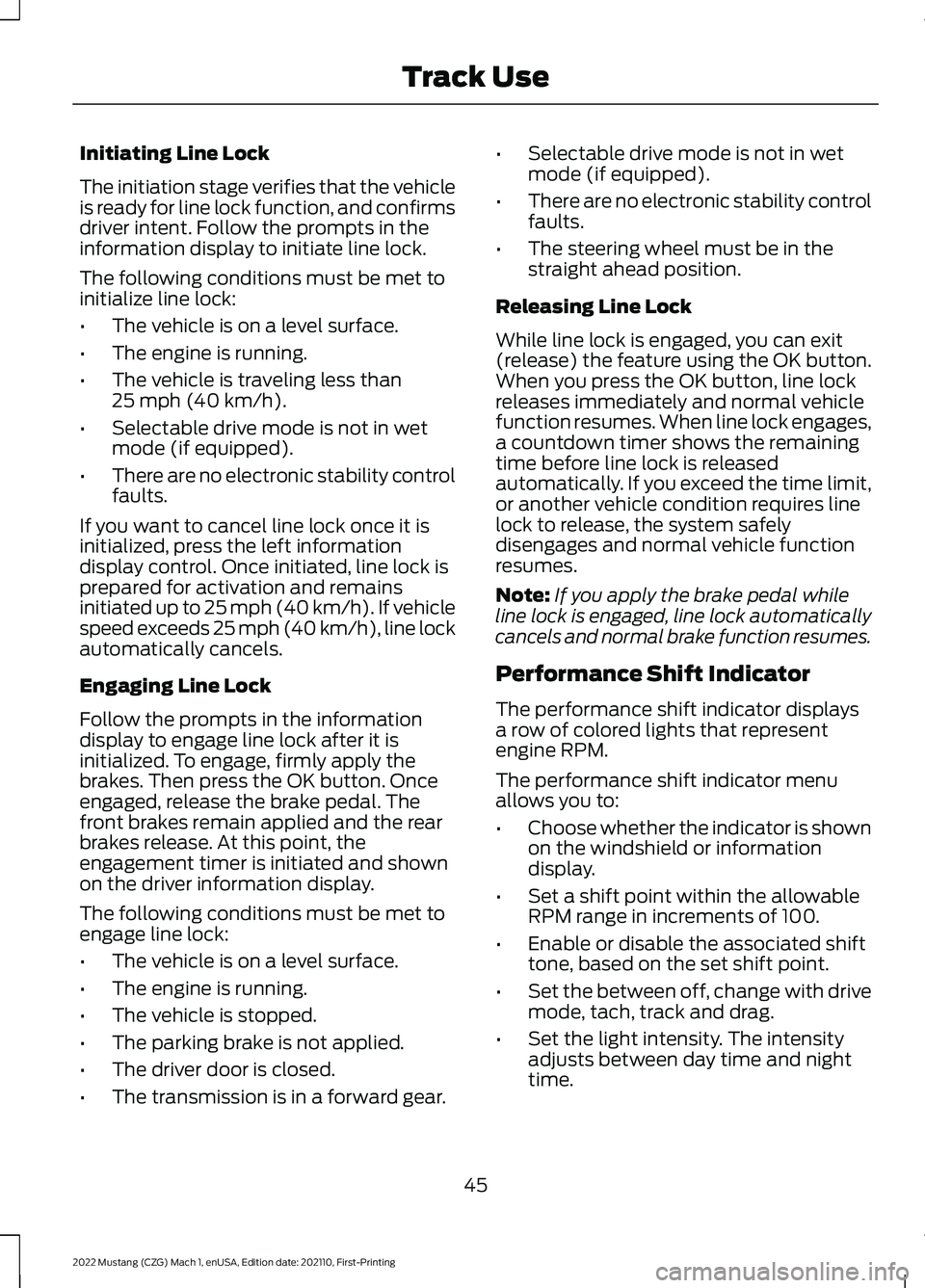
Initiating Line Lock
The initiation stage verifies that the vehicle
is ready for line lock function, and confirms
driver intent. Follow the prompts in the
information display to initiate line lock.
The following conditions must be met to
initialize line lock:
•
The vehicle is on a level surface.
• The engine is running.
• The vehicle is traveling less than
25 mph (40 km/h).
• Selectable drive mode is not in wet
mode (if equipped).
• There are no electronic stability control
faults.
If you want to cancel line lock once it is
initialized, press the left information
display control. Once initiated, line lock is
prepared for activation and remains
initiated up to 25 mph (40 km/h). If vehicle
speed exceeds 25 mph (40 km/h), line lock
automatically cancels.
Engaging Line Lock
Follow the prompts in the information
display to engage line lock after it is
initialized. To engage, firmly apply the
brakes. Then press the OK button. Once
engaged, release the brake pedal. The
front brakes remain applied and the rear
brakes release. At this point, the
engagement timer is initiated and shown
on the driver information display.
The following conditions must be met to
engage line lock:
• The vehicle is on a level surface.
• The engine is running.
• The vehicle is stopped.
• The parking brake is not applied.
• The driver door is closed.
• The transmission is in a forward gear. •
Selectable drive mode is not in wet
mode (if equipped).
• There are no electronic stability control
faults.
• The steering wheel must be in the
straight ahead position.
Releasing Line Lock
While line lock is engaged, you can exit
(release) the feature using the OK button.
When you press the OK button, line lock
releases immediately and normal vehicle
function resumes. When line lock engages,
a countdown timer shows the remaining
time before line lock is released
automatically. If you exceed the time limit,
or another vehicle condition requires line
lock to release, the system safely
disengages and normal vehicle function
resumes.
Note: If you apply the brake pedal while
line lock is engaged, line lock automatically
cancels and normal brake function resumes.
Performance Shift Indicator
The performance shift indicator displays
a row of colored lights that represent
engine RPM.
The performance shift indicator menu
allows you to:
• Choose whether the indicator is shown
on the windshield or information
display.
• Set a shift point within the allowable
RPM range in increments of 100.
• Enable or disable the associated shift
tone, based on the set shift point.
• Set the between off, change with drive
mode, tach, track and drag.
• Set the light intensity. The intensity
adjusts between day time and night
time.
45
2022 Mustang (CZG) Mach 1, enUSA, Edition date: 202110, First-Printing Track Use
Page 49 of 81
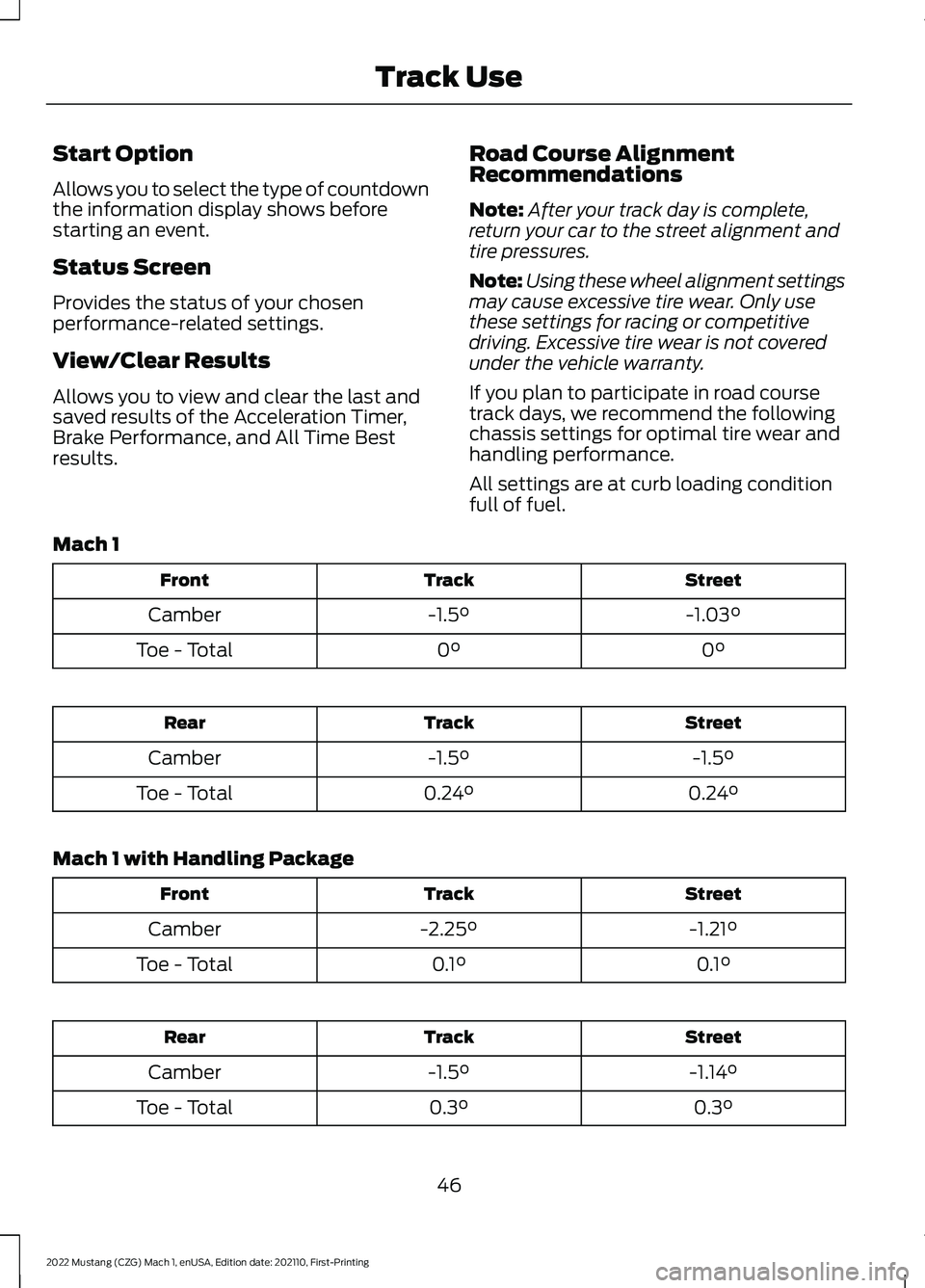
Start Option
Allows you to select the type of countdown
the information display shows before
starting an event.
Status Screen
Provides the status of your chosen
performance-related settings.
View/Clear Results
Allows you to view and clear the last and
saved results of the Acceleration Timer,
Brake Performance, and All Time Best
results.
Road Course Alignment
Recommendations
Note:
After your track day is complete,
return your car to the street alignment and
tire pressures.
Note: Using these wheel alignment settings
may cause excessive tire wear. Only use
these settings for racing or competitive
driving. Excessive tire wear is not covered
under the vehicle warranty.
If you plan to participate in road course
track days, we recommend the following
chassis settings for optimal tire wear and
handling performance.
All settings are at curb loading condition
full of fuel.
Mach 1 Street
Track
Front
-1.03°
-1.5°
Camber
0°
0°
Toe - Total Street
Track
Rear
-1.5°
-1.5°
Camber
0.24°
0.24°
Toe - Total
Mach 1 with Handling Package Street
Track
Front
-1.21°
-2.25°
Camber
0.1°
0.1°
Toe - Total Street
Track
Rear
-1.14°
-1.5°
Camber
0.3°
0.3°
Toe - Total
46
2022 Mustang (CZG) Mach 1, enUSA, Edition date: 202110, First-Printing Track Use
Page 50 of 81

Track Tire Pressures
Cold Tire Pressures
Rear
Front
Tire Pressure
30 psi (2.07 bar)
30 psi (2.07 bar)
Mach 1
28 psi (1.93 bar)
28 psi (1.93 bar)
Mach 1 with Handling
Package
Hot Tire Pressures Rear
Front
Tire Pressure
Less than 38 psi (2.62 bar)
Less than 38 psi (2.62 bar)
Mach 1
Less than
36 psi (2.48 bar)
Less than 36 psi (2.48 bar)
Mach 1 with Handling
Package
Track Use Maintenance Intervals
Follow these maintenance intervals for
when you use your vehicle on a track or in
a high-speed event. Vehicle Use and Example
Interval
Change the engine oil and filter
One track weekend or approximately 4
hours of track use
Change the rear axle fluid1
Every
500 mi (800 km)
1 Change the fluid every 500 mi (800 km) or when a message appears in the information
display stating that the axle fluid is over temperature.
Adjustable Camber Front Strut
Top Mounts (vehicles with
Optional Handling Package)
Your vehicle has adjustable strut mounts
which you can use to adjust the camber of
your vehicle before and after a track event
to the specifications listed in the Road
Course Alignment Recommendations table
previously shown. Note:
After your track day is complete,
return your car to the street alignment and
tire pressures.
47
2022 Mustang (CZG) Mach 1, enUSA, Edition date: 202110, First-Printing Track Use